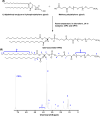Synthesis and characterization of lipid-polymer hybrid nanoparticles with pH-triggered poly(ethylene glycol) shedding
- PMID: 21806013
- PMCID: PMC3166210
- DOI: 10.1021/la202123e
Synthesis and characterization of lipid-polymer hybrid nanoparticles with pH-triggered poly(ethylene glycol) shedding
Abstract
Novel lipid-polymer hybrid nanoparticles are designed with a poly(ethylene glycol) (PEG) coating that is shed in response to a low pH trigger. This allows the nanoparticles to be stable during systemic circulation and at neutral pH, but destabilize and fuse with lipid membranes in acidic environments. The hybrid nanoparticles consist of a poly(lactic-co-glycolic acid) core with a lipid and lipid-PEG monolayer shell. To make the hybrid nanoparticles pH sensitive, a lipid-(succinate)-mPEG conjugate is synthesized to provide a hydrolyzable PEG stealth layer that is shed off the particle surface at low pH. The pH-sensitivity of the nanoparticles is tunable using the molar concentration of the lipid-(succinate)-mPEG incorporated in the lipid shell of the particles. Possible uses of these pH-sensitive nanoparticles include aggregating in acidic tumor microenvironments, escaping acidified endosomes, or aggregating in deep lung tissue for improved inhalation administration.
© 2011 American Chemical Society
Figures






Similar articles
-
Lipid-polymer hybrid nanoparticles as a new generation therapeutic delivery platform: a review.Eur J Pharm Biopharm. 2013 Nov;85(3 Pt A):427-43. doi: 10.1016/j.ejpb.2013.07.002. Epub 2013 Jul 17. Eur J Pharm Biopharm. 2013. PMID: 23872180 Review.
-
Folate-modified lipid-polymer hybrid nanoparticles for targeted paclitaxel delivery.Int J Nanomedicine. 2015 Mar 16;10:2101-14. doi: 10.2147/IJN.S77667. eCollection 2015. Int J Nanomedicine. 2015. PMID: 25844039 Free PMC article.
-
Fabrication Of Dual pH/redox-Responsive Lipid-Polymer Hybrid Nanoparticles For Anticancer Drug Delivery And Controlled Release.Int J Nanomedicine. 2019 Oct 3;14:8001-8011. doi: 10.2147/IJN.S226798. eCollection 2019. Int J Nanomedicine. 2019. PMID: 31632014 Free PMC article.
-
Engineering pH-sensitive dissolution of lipid-polymer nanoparticles by Eudragit integration impacts plasmid DNA (pDNA) transfection.Eur J Pharm Biopharm. 2024 Jun;199:114299. doi: 10.1016/j.ejpb.2024.114299. Epub 2024 Apr 20. Eur J Pharm Biopharm. 2024. PMID: 38643953
-
Poly (Lactic-co-Glycolic Acid) & Tocopheryl Polyethylene Glycol Succinate Nanoparticles for the Treatment of Different Brain Cancers.Anticancer Agents Med Chem. 2021;21(15):1977-1986. doi: 10.2174/1871520621666210204201347. Anticancer Agents Med Chem. 2021. PMID: 33563201 Review.
Cited by
-
Biomaterials for mRNA delivery.Biomater Sci. 2015 Dec;3(12):1519-33. doi: 10.1039/c5bm00198f. Epub 2015 Aug 17. Biomater Sci. 2015. PMID: 26280625 Free PMC article.
-
Effect of partial PEGylation on particle uptake by macrophages.Nanoscale. 2017 Jan 7;9(1):288-297. doi: 10.1039/c6nr07353k. Epub 2016 Dec 2. Nanoscale. 2017. PMID: 27909711 Free PMC article.
-
Herringbone-Patterned 3D-Printed Devices as Alternatives to Microfluidics for Reproducible Production of Lipid Polymer Hybrid Nanoparticles.ACS Omega. 2019 Mar 4;4(3):4650-4657. doi: 10.1021/acsomega.9b00128. eCollection 2019 Mar 31. ACS Omega. 2019. PMID: 31459652 Free PMC article.
-
Nanotechnology-based antiviral therapeutics.Drug Deliv Transl Res. 2021 Jun;11(3):748-787. doi: 10.1007/s13346-020-00818-0. Drug Deliv Transl Res. 2021. PMID: 32748035 Free PMC article. Review.
-
Ultra-small lipid-polymer hybrid nanoparticles for tumor-penetrating drug delivery.Nanoscale. 2016 Aug 14;8(30):14411-9. doi: 10.1039/c6nr04091h. Epub 2016 Jul 14. Nanoscale. 2016. PMID: 27411852 Free PMC article.
References
-
- Zhang L, Gu FX, Chan JM, Wang AZ, Langer RS, Farokhzad OC. Clin. Pharmacol. Ther. 2007;83:761–769. - PubMed
-
- Langer R. Nature. 1998;392:5–10. - PubMed
-
- Ferrari M. Nat. Nanotechnol. 2007;2:37–47.
-
- Venkataraman S, Ong WL, Ong ZY, Loo SCJ, Ee PLR, Yang YY. Biomaterials. 2011;32:2369–2378. - PubMed
-
- Owens DE, Peppas NA. Int. J. Pharm. 2006;307:93–102. - PubMed
Publication types
MeSH terms
Substances
Grants and funding
LinkOut - more resources
Full Text Sources
Other Literature Sources

